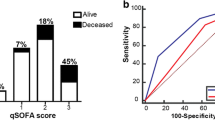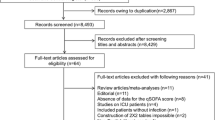Abstract
Objective
To empirically test, based on a large multicenter, multinational database, whether a modified PIRO (predisposition, insult, response, and organ dysfunction) concept could be applied to predict mortality in patients with infection and sepsis.
Design
Substudy of a multicenter multinational cohort study (SAPS 3).
Patients
A total of 2,628 patients with signs of infection or sepsis who stayed in the ICU for > 48 h. Three boxes of variables were defined, according to the PIRO concept. Box 1 (Predisposition) contained information about the patient's condition before ICU admission. Box 2 (Injury) contained information about the infection at ICU admission. Box 3 (Response) was defined as the response to the infection, expressed as a Sequential Organ Failure Assessment score after 48 h.
Interventions
None.
Main measurements and results
Most of the infections were community acquired (59.6%); 32.5% were hospital acquired. The median age of the patients was 65 (50–75) years, and 41.1% were female. About 22% (n = 576) of the patients presented with infection only, 36.3% (n = 953) with signs of sepsis, 23.6% (n = 619) with severe sepsis, and 18.3% (n = 480) with septic shock. Hospital mortality was 40.6% overall, greater in those with septic shock (52.5%) than in those with infection (34.7%). Several factors related to predisposition, infection and response were associated with hospital mortality.
Conclusion
The proposed three-level system, by using objectively defined criteria for risk of mortality in sepsis, could be used by physicians to stratify patients at ICU admission or shortly thereafter, contributing to a better selection of management according to the risk of death.

Similar content being viewed by others
References
Bone RC, Balk RA, Cerra FB, Dellinger RP, Fein AM, Knaus WA, Schein RM, Sibbald WJ (1992) Definitions for sepsis and organ failure and guidelines for the use of innovative therapies in sepsis. The ACCP/SCCM Consensus Conference Committee. American College of Chest Physicians/Society of Critical Care Medicine. Chest 101:1644–1655
Vincent JL (1997) Dear SIRS, I'm sorry to say that I don't like you ... Crit Care Med 25:372–374
Levy MM, Fink MP, Marshall JC, Abraham E, Angus D, Cook D, Cohen J, Opal SM, Vincent JL, Ramsay G, International Sepsis Definitions Conference (2003) 2001 SCCM/ESICM/ACCP/ATS/SIS International Sepsis Definitions Conference. Intensive Care Med 29:530–538
Marshall JC, Vincent JL, Fink MP, Cook DJ, Rubenfeld G, Foster D, Fisher CJ Jr, Faist E, Reinhart K (2003) Measures, markers, and mediators: Toward a staging system for clinical sepsis. A Report of the Fifth Toronto Sepsis Roundtable, Toronto, Ontario, Canada, 25–26 October, 2000. Crit Care Med 31:1560–1567
Vincent JL, Wendon J, Groeneveld J, Marshall JC, Streat S, Carlet J (2003) The PIRO Concept: O is for organ dysfunction. Crit Care 7:260–264
Angus DC, Burgner D, Wunderink R, Mira JP, Gerlach H, Wiedermann CJ, Vincent JL (2003) The PIRO Concept: P is for predisposition. Crit Care 7:248–251
Gerlach H, Dhainaut JF, Harbarth S, Reinhart K, Marshall JC, Levy M (2003) The PIRO Concept: R is for response. Crit Care 7:256–259
Vincent JL, Opal S, Torres A, Bonten M, Cohen J, Wunderink R (2003) The PIRO Concept: I is for infection. Crit Care 7:252–255
Metnitz PG, Moreno RP, Almeida E, Jordan B, Bauer P, Campos RA, Iapichino G, Edbrooke D, Capuzzo M, Le Gall JR; SAPS 3 Investigators (2005) SAPS 3. From evaluation of the patient to evaluation of the intensive care unit. Part 1: Objectives, methods and cohort description. Intensive Care Med 31:1336–1344
Moreno RP, Metnitz PG, Almeida E, Jordan B, Bauer P, Campos RA, Iapichino G, Edbrooke D, Capuzzo M, Le Gall JR; SAPS 3 Investigators (2005) SAPS 3. From evaluation of the patient to evaluation of the intensive care unit. Part 2: Development of a prognostic model for hospital mortality at ICU admission. Intensive Care Med 31:1345–1355
Vincent JL, Moreno R, Takala J, Willatts S, De Mendonca A, Bruining H, Reinhart CK, Suter PM, Thijs LG (1996) The SOFA (Sepsis-related Organ Failure Assessment) score to describe organ dysfunction/failure. Intensive Care Med 22:707–710
Kramer MS, Feinstein AR (1981) Clinical biostatistics. LIV. The biostatistics of concordance. Clin Pharmacol Ther 29:111–123
Hosmer DW, Lemeshow S (1995) Confidence interval estimates of an index of quality performance based on logistic regression estimates. Stat Med 14:2161–2172
Lemeshow S, Hosmer DW (1982) A review of goodness of fit statistics for use in the development of logistic regression models. Am J Epidemiol 115:92–106
Hanley J, McNeil B (1982) The meaning and use of the area under a receiver operating characteristic (ROC) curve. Radiology 143:29–36
Alberti C, Brun-Buisson C, Burchardi H, Martin C, Goodman S, Artigas A, Sicignano A, Palazzo M, Moreno R, Boulmé R, Lepage E, Le Gall R (2002) Epidemiology of sepsis and infection in ICU patients from an international multicentre cohort study. Intensive Care Med 28:108–121
Martin GS, Mannino DM, Eaton S, Moss M (2003) The epidemiology of sepsis in the United States from 1979 through 2000. N Engl J Med 348:1546–1554
Moreno R, Afonso S, Fevereiro T (2006) Incidence of sepsis in hospitalized patients. Curr Infect Dis Rep 8:346–350
Dellinger RP, Carlet JM, Masur H, Gerlach H, Calandra T, Cohen J, Gea-Banacloche J, Keh D, Marshall JC, Parker MM, Ramsay G, Zimmerman JL, Vincent JL, Levy MM (2004) Surviving Sepsis Campaign guidelines for the management of severe sepsis and septic shock. Intensive Care Med 30:536–555
Rangel-Frausto MS, Pittet D, Costigan M, Hwang T, Davis CS, Wenzel RP (1995) The natural history of the systemic inflammatory response syndrome (SIRS). A prospective study. JAMA 273:117–123
Alberti C, Brun-Buisson C, Goodman SV, Guidici D, Granton J, Moreno R, Smithies M, Thomas O, Artigas A, Le Gall JR, European Sepsis Group (2003) Influence of systemic inflammatory response syndrome and sepsis on outcome of critically ill infected patients. Am J Respir Crit Care Med 168:77–84
Alberti C, Brun-Buisson C, Chevret S, Antonelli M, Goodman SV, Martin C, Moreno R, Ochagavia AR, Palazzo M, Werdan K, Le Gall JR, European Sepsis Study Group (2005) Systemic inflammatory response and progression to severe sepsis in critically ill infected patients. Am J Respir Crit Care Med 171:461–468
Finkielman JD, Dara SI, Mohammad Z, Sujay B, Afessa B (2004) Sepsis mortality prediction based on predisposition, infection, response and organ dysfunction (PIRO) [Abstract]. Crit Care Med 32:A134
Carlet J (2006) Prescribing indications based on successful clinical trials in sepsis: a difficult exercise. Crit Care Med 34:525–529
Vincent JL, Sakr Y, Sprung CL, Ranieri VM, Reinhart K, Gerlach H, Moreno R, Carlet J, Le Gall JR, Payen D, Sepsis Occurrence in Acutely Ill Patients Investigators (2006) Sepsis in European intensive care units: Results of the SOAP study. Crit Care Med 34:344–353
Flaatten H (2004) Epidemiology of sepsis in Norway in 1999. Crit Care 8:R180–R184
Harrison DA (2006) The epidemiology of severe sepsis in England, Wales and Northern Ireland, 1996 to 2004: secondary analysis of a high quality clinical database, the ICNARC Case Mix Programme Database. Crit Care 10:doi:10.1186/cc4854
Friedman G, Silva E, Vincent JL (1998) Has the mortality of septic shock changed with time? Crit Care Med 26:2078–2086
Karlsson S, Varpula M, Ruokonen E, Pettila V, Parviainen I, Ala-Kokko TI, Kolho E, Rintala EM (2007) Incidence, treatment, and outcome of severe sepsis in ICU-treated adults in Finland: the Finnsepsis study. Intensive Care Med 33:435–443
Rangel-Frausto MS (1999) The epidemiology of bacterial sepsis. Infect Clin North Am 13:299–312
Angus DC, Linde-Zwirble WT, Lidicker J, Clermont G, Carcillo J, Pinsky MR (2001) Epidemiology of severe sepsis in the United States: analysis of incidence, outcome and associated costs of care. Crit Care Med 29:1303–1310
Acknowledgements
Statistical analysis was supported by a grant from the Fund of the Austrian National Bank, Project # 10995 ONB. Our thanks go to the participants from all over the world who dedicated a significant amount of their time and effort to this project, proving that it is still possible to conduct a worldwide academic study. The complete list of participants can be found in Appendix D of the ESM.
Author information
Authors and Affiliations
Consortia
Corresponding author
Electronic supplementary material
Rights and permissions
About this article
Cite this article
Moreno, R.P., Metnitz, B., Adler, L. et al. Sepsis mortality prediction based on predisposition, infection and response. Intensive Care Med 34, 496–504 (2008). https://doi.org/10.1007/s00134-007-0943-1
Received:
Accepted:
Published:
Issue Date:
DOI: https://doi.org/10.1007/s00134-007-0943-1




